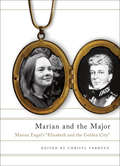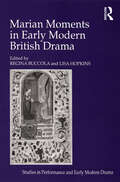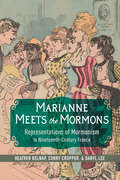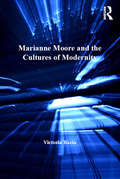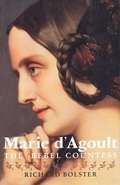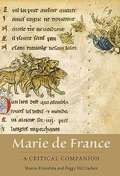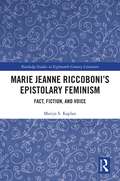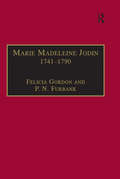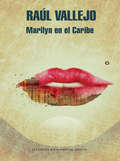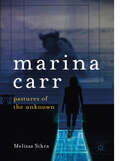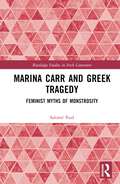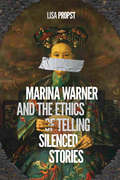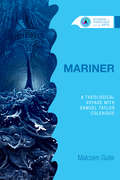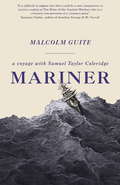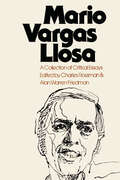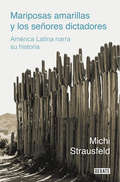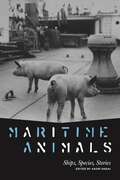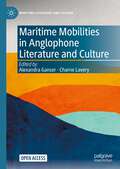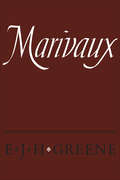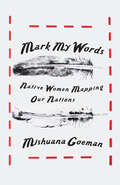- Table View
- List View
Marian and the Major
by Marian Engel Christl VerduynRains, a former soldier in the Napoleonic Wars, immigrated to Canada at the same period as Susanna Moodie and Catharine Parr Traill. He brought with him his wards, sisters Frances and Elizabeth. The three settled on St Joseph Island in northern Ontario, where their unusual domestic arrangement caught the attention and imagination of, among others, the nineteenth-century British travel-writer Anna Jameson, the Swiss born naturalist and explorer Louis Agassiz, the American poet William Cullen Bryant, and the Canadian novelist Marian Engel.
Marian and the Major: Engel's "Elizabeth and the Golden City"
by Marian Engel Christl VerduynRains, a former soldier in the Napoleonic Wars, immigrated to Canada at the same period as Susanna Moodie and Catharine Parr Traill. He brought with him his wards, sisters Frances and Elizabeth. The three settled on St Joseph Island in northern Ontario, where their unusual domestic arrangement caught the attention and imagination of, among others, the nineteenth-century British travel-writer Anna Jameson, the Swiss born naturalist and explorer Louis Agassiz, the American poet William Cullen Bryant, and the Canadian novelist Marian Engel.
Marian Moments in Early Modern British Drama (Studies In Performance And Early Modern Drama Ser.)
by Lisa HopkinsConcerning itself with the complex interplay between iconoclasm against images of the Virgin Mary in post-Reformation England and stage representations that evoke various 'Marian moments' from the medieval, Catholic past, this collection answers the call for further investigation of the complex relationship between the fraught religio-political culture of the early modern period and the theater that it spawned. Joining historians in rejecting the received belief that Catholicism could be turned on and off like a water spigot in response to sixteenth-century religious reform, the early modern British theater scholars in this collection turn their attention to the vestiges of Catholic tradition and culture that leak out in stage imagery, plot devices, and characterization in ways that are not always clearly engaged in the business of Protestant panegyric or polemic. Among the questions they address are: What is the cultural function of dramatic Marian moments? Are Marian moments nostalgic for, or critical of, the 'Old Faith'? How do Marian moments negotiate the cultural trauma of iconoclasm and/or the Reformation in early modern England? Did these stage pictures of Mary provide subversive touchstones for the Old Faith of particular import to crypto-Catholic or recusant members of the audience?
Marianne Meets the Mormons: Representations of Mormonism in Nineteenth-Century France
by Heather Belnap Corry Cropper Daryl LeeIn the nineteenth century, a fascination with the Church of Jesus Christ of Latter-day Saints made Mormons and Mormonism a common trope in French journalism, art, literature, politics, and popular culture. Heather Belnap, Corry Cropper, and Daryl Lee bring to light French representations of Mormonism from the 1830s to 1914, arguing that these portrayals often critiqued and parodied French society. Mormonism became a pretext for reconsidering issues such as gender, colonialism, the family, and church-state relations while providing artists and authors with a means for working through the possibilities of their own evolving national identity. Surprising and innovative, Marianne Meets the Mormons looks at how nineteenth-century French observers engaged with the idea of Mormonism in order to reframe their own cultural preoccupations.
Marianne Moore and the Cultures of Modernity
by Victoria BazinVictoria Bazin examines the poetry of Marianne Moore as it is shaped by and responsive to the experience of being a modern woman, of living in the aftermath of the First World War, of being interpellated as a modern consumer and of writing in "the age of mechanical reproduction." She argues that Moore's textual collages and syllabic sculptures are based on the cultural clutter or debris of modernity, on textual extracts and reproductions, on the phantasmagoria of city life revealing something modernism worked hard to conceal: its relation to modernity, more specifically its relation to the new emerging and expanding mass consumer culture. Drawing extensively on archival resources to trace Moore's influences and to describe her own distinctive modernist aesthetic, this book argues that it was her feminist adaptation of pragmatism that shaped her poetic response to modernity. Moore's use of the quoted fragment is conceptualised in relation not only to Walter Benjamin's philosophical history but also to William James's image of the world as a series of "partial stories." As such, this account of Marianne Moore not only contributes to a greater understanding of the poet and her work, but it also offers up a more politicized and historically nuanced understanding of poetic modernism between the wars, one that retains a sense of the formal complexities of poetic language and the poet's own ethical imperatives whilst also recognising the material impact of modernity upon the modernist poem. This book will appeal, therefore, not only to scholars already familiar with Moore's poetry but more widely to those interested in modernism and American culture between the wars.
Marie d'Agoult: The Rebel Countess
by Richard Bolster"Talented and resolutely independent, Marie d'Agoult (1805-76) was one of the most remarkable women of her time. Abandoning her privileged position in society, she eloped with her great love, the pianist and composer Franz Liszt, and later won fame as a writer under the pen name Daniel Stern. She published fiction, articles on literature, music, art and politics, and a history of the revolution of 1848, and she was an eloquent advocate for democracy, the eradication of poverty, and the emancipation of women. "Drawing on her memoirs, letters, and other unpublished writings, Richard Bolster's biography sets Marie d'Agoult's eventful life against a backdrop of dramatic political change in France."--BOOK JACKET. Title Summary field provided by Blackwell North America, Inc. All Rights Reserved
Marie De France: A Critical Companion (Gallica #Volume 24)
by Sharon Kinoshita Peggy McCrackenMarie de France is the author of some of the most influential and important works to survive from the middle ages; arguably best-known for her Lais, she also translated Aesop's Fables (the Ysopë), and wrote the Espurgatoire seint Patriz (St Patrick's Purgatory), based on a Latin text. The aim of this Companion is both to provide information on what can be gleaned of her life, and on her poetry, and to rethink standard questions of interpretation, through topics with special relevance to medieval literature and culture. The variety of perspectives used highlights both the unity of Marie's oeuvre and the distinctiveness of the individual texts. After situating her writings in their Anglo-Norman political, linguistic, and literary context, this volume considers her treatment of questions of literary composition in relation to the circulation, transmission, and interpretation of her works. Her social and historical engagements are illuminated by the prominence of feudal vocabulary, while her representation of movement across different geographical and imaginary spaces opens a window on plot construction. Repetition and variation are considered as a narrative technique within Marie's work, and as a cultural practice linking her texts to a network of twelfth-century textual traditions. The Conclusion, on the posterity of her oeuvre, combines a consideration of manuscript context with the ways in which later authors rewrote Marie's works. Sharon Kinoshita is Professor of Literature, University of California, Santa Cruz; Peggy McCracken is Professor of French, Women's Studies, and Comparative Literature, University of Michigan, Ann Arbor.
Marie Jeanne Riccoboni’s Epistolary Feminism: Fact, Fiction, and Voice (Routledge Studies in Eighteenth-Century Literature)
by Marijn S. KaplanMarie Jeanne Riccoboni’s Epistolary Feminism: Fact, Fiction, and Voice argues that Riccoboni is among the most significant women writers of the French Enlightenment due to her "epistolary feminism". Locating its source in her first novel Lettres de Mistriss Fanni Butlerd (1757), between fact and fiction, public and private, Marijn S. Kaplan provides new evidence supporting both the novel’s autobiography theory and de Maillebois hypothesis. Kaplan then traces how Riccoboni progressively develops a proto-feminist poetics of voice in her epistolary fiction, empowering women to resist patriarchal efforts to silence and appropriate them, which culminates in her final novel Lettres de Milord Rivers (1777). In nineteen relatively unknown letters (included, with translations) written over three decades to her publisher Humblot, several editors, Diderot, Laclos, Philip Thicknesse etc., Riccoboni is shown similarly to defend her oeuvre, her reputation, and her authority as a woman (writer), refusing to be manipulated and silenced by men.
Marie Madeleine Jodin 1741–1790: Actress, Philosophe and Feminist (Women and Gender in the Early Modern World)
by Felicia Gordon P.N. FurbankThe life story of Marie-Madeleine Jodin opens an exciting new perspective on the world of 18th-century women, European court theatres, and, most strikingly, entails the remarkable discovery of a previously unknown French feminist. In 1790, Jodin, a protégée of Denis Diderot and a former actress, published a treatise entitled Vues législatives pour les femmes (Legislative Views for Women), which can lay claim to being the first signed, female-authored feminist manifesto of the French Revolutionary period, and which reveals Jodin's wide reading in women's history and feminist writing since ancient times. This new critical and contextual biography traces the turbulent life of an extraordinary woman, focusing particularly on her transformation from artisan's daughter, to tragic actress, to Enlightenment intellectual and feminist. The authors analyze the confrontations and scandals that beset her career, and read her feminist treatise-here reproduced, for the first time in English, in its entirety-as the summation of a chaotic but passionate existence. Also presented for the first time in English, fully set in their biographical and historical context, are the twenty-one letters that constitute Diderot's correspondence with Jodin. The varied and fascinating documentation concerning Jodin, which has only recently been discovered, provides a window on the world of 18th-century women. While memoirs and biographies of aristocratic women and upwardly mobile salonières such as Mme. Geoffrin and Mme. Roland are legion, chronicles of the lives of individual women lower down the social ladder are far fewer in number. A contemporary of Mary Wollstonecraft and Olympe de Gouges, Jodin argued for the social reform of working-class women, particularly prostitutes, to render them worthy to exercise the rights of citizenship.
Marigold - Book Five class 5 - NCERT - 23
by National Council of Educational Research and Training"Marigold - Book Five" by NCERT is a textbook designed for fifth-grade students studying English. The book is a compilation of diverse and engaging literary pieces, including prose, poetry, and illustrations, aiming to develop language skills and foster a love for literature. It covers a wide range of themes such as nature, moral values, folktales, and contemporary stories. Through its carefully selected texts, the book encourages students to explore different facets of the English language, enhancing their reading comprehension, vocabulary, and grammar. With its interactive exercises, thought-provoking stories, and poems, "Marigold - Book Five" serves as a comprehensive resource to inspire young learners and cultivate their appreciation for the English language and literature while facilitating a holistic learning experience.
MARILYN EN EL CARIBE E-BOOK
by Raul VallejoEn su fallo, el jurado del Premio de Novela Breve Pontificia UniversidadJaveriana 2014 señaló que Marilyn en el Caribe, la obra ganadora, es unanovela "... fresca y de escritura muy fluida en la que hay que destacartambién el manejo de los diálogos. Su estructura propone una lectura condiversas líneas de interpretación; presenta un juego meta ?ccional entresujetos históricos y personajes de ficción, conjugados de maneraverosímil. Además, combina diversos registros de lenguaje, logrando ununiverso poético y narrativo pleno de posibilidades estéticas".
Marina Carr: Pastures of the Unknown
by Melissa SihraThis book locates the theatre of Marina Carr within a female genealogy that revises the patriarchal origins of modern Irish drama. The creative vision of Lady Augusta Gregory underpins the analysis of Carr’s dramatic vision throughout the volume in order to re-situate the woman artist as central to Irish theatre. For Carr, ‘writing is more about the things you cannot understand than the things you can’, and her evocation of ‘pastures of the unknown’ forms the thematic through-line of this work. Lady Gregory’s plays offer an intuitive lineage with Carr which can be identified in their use of language, myth, landscape, women, the transformative power of storytelling and infinite energies of nature and the Otherworld. This book reconnects the severed bridge between Carr and Gregory in order to acknowledge a foundational status for all women in Irish theatre.
Marina Carr and Greek Tragedy: Feminist Myths of Monstrosity (Routledge Studies in Irish Literature)
by Salomé PaulMarina Carr and Greek Tragedy examines the feminist transposition of Greek tragedy in the theatre of the contemporary Irish dramatist Marina Carr. Through a comparison of the plays based on classical drama with their ancient models, it investigates Carr’s transformation not only of the narrative but also of the form of Greek tragedy. As a religious and political institution of the 5th-century Athenian democracy, tragedy endorsed the sexist oppression of women. Indeed, the construction of female characters in Greek tragedy was entirely disconnected from the experience of womanhood lived by real women in order to embody the patriarchal values of Athenian democracy. Whether praised for their passivity or demonized for showing unnatural agency and subjectivity, women in Greek tragedy were conceived to (re)assert the supremacy of men. Carr’s theatre stands in stark opposition to such a purpose. Focusing on women’s struggle to achieve agency and subjectivity in a male-dominated world, her plays show the diversity of experiencing womanhood and sexist oppression in the Republic of Ireland, and the Western societies more generally. Yet, Carr’s enduring conversation with the classics in her theatre demonstrates the feminist willingness to alter the founding myths of Western civilisation to advocate for gender equality.
Marina Warner and the Ethics of Telling Silenced Stories
by Lisa PropstEfforts to fight back against silencing are central to social justice movements and scholarly fields such as feminist and postcolonial studies. But claiming to give voice to people who have been silenced always risks appropriating those people's stories. Lisa Propst argues that the British novelist and public intellectual Marina Warner offers some of the most provocative contemporary interventions into this dilemma. Tracing her writing from her early journalism to her novels, short stories, and studies of myths and fairy tales, Propst shows that in Warner's work, features such as stylized voices and narrative silences - tales that Warner's books hint at but never tell - question the authority of the writer to tell other people's stories. At the same time they demonstrate the power of literature to make new ethical connections between people, inviting readers to reflect on whom they are responsible to and how they are implicated in social systems that perpetuate silencing. By exploring how to combat silencing through narrative without reproducing it, Marina Warner and the Ethics of Telling Silenced Stories takes up an issue crucial not just to literature and art but to journalists, policy makers, human rights activists, and all people striving to formulate their own responses to injustice.
Mariner: A Theological Voyage with Samuel Taylor Coleridge (Studies in Theology and the Arts)
by Malcolm GuiteInstead of the cross, the Albatross About my neck was hung.
Mariner: A Voyage with Samuel Taylor Coleridge
by Reverend Dr Malcolm Guite'The story of Coleridge's life does undoubtedly echo that of his poem; this is a book that provides rewarding rereadings of both' - The Sunday TimesA new biography of Samuel Taylor Coleridge, shaped and structured around the story he himself tells in his most famous poem, 'The Rime of the Ancient Mariner'. Though the 'Mariner' was written in 1797 when Coleridge was only twenty-five, it was an astonishingly prescient poem. As Coleridge himself came to realise much later, this tale - of a journey that starts in high hopes and good spirits, but leads to a profound encounter with human fallibility, darkness, alienation, loneliness and dread, before coming home to a renewal of faith and vocation - was to be the shape of his own life. In this rich new biography, academic, priest and poet Malcolm Guite draws out how with an uncanny clarity, image after image and event after event in the poem became emblems of what Coleridge was later to suffer and discover. Of course 'The Rime of the Ancient Mariner' is more than just an individual's story: it is also a profound exploration of the human condition and, as Coleridge says in his gloss, our 'loneliness and fixedness'. But the poem also offers hope, release, and recovery; and Guite also draws out the continuing relevance of Coleridge's life and writing to our own time.'Forcefully and convincingly argued' - The Telegraph
Mariner: A Voyage with Samuel Taylor Coleridge
by Reverend Dr Malcolm Guite'The story of Coleridge's life does undoubtedly echo that of his poem; this is a book that provides rewarding rereadings of both' - The Sunday TimesA new biography of Samuel Taylor Coleridge, shaped and structured around the story he himself tells in his most famous poem, 'The Rime of the Ancient Mariner'. Though the 'Mariner' was written in 1797 when Coleridge was only twenty-five, it was an astonishingly prescient poem. As Coleridge himself came to realise much later, this tale - of a journey that starts in high hopes and good spirits, but leads to a profound encounter with human fallibility, darkness, alienation, loneliness and dread, before coming home to a renewal of faith and vocation - was to be the shape of his own life. In this rich new biography, academic, priest and poet Malcolm Guite draws out how with an uncanny clarity, image after image and event after event in the poem became emblems of what Coleridge was later to suffer and discover. Of course 'The Rime of the Ancient Mariner' is more than just an individual's story: it is also a profound exploration of the human condition and, as Coleridge says in his gloss, our 'loneliness and fixedness'. But the poem also offers hope, release, and recovery; and Guite also draws out the continuing relevance of Coleridge's life and writing to our own time.'Forcefully and convincingly argued' - The Telegraph
Mario Vargas Llosa: A Collection of Critical Essays
by Charles Rossman and Alan Warren FriedmanThe Peruvian Mario Vargas Llosa has been acclaimed throughout the literary world as one of Latin America's finest writers, yet until recently little has been written about his work in English. While his work has the subject of an increasing flow of critical commentary in Spanish and his major novels have been translated into English, this is the first full-scale critical treatment of Vargas Llosa published in the English language. These articles by a number of established writers and critics appraise Vargas Llosa's individual novels as well as the body of his work. The Time of the Hero, The Green House, Conversation in The Cathedral, and Pantaleón y las visitadoras are examined in order of publication, A second group of more general essays ranges across Vargas Llosa's work and explores pervasive themes and concerns. Two pieces by José Miguel Oviedo serve as a coda. In a bilingual interview, Oviedo and Vargas Llosa discuss Vargas Llosa's novel La tía Julia y el escribidor. Oviedo concludes with a critical discussion of that novel. A Vargas Llosa chronology compiled by the editors is also included. Most of these essays originally appeared in 1977 as a special issue of Texas Studies in Literature and Language. The concluding essay by Oviedo was prepared especially for this edition.
Mariposas amarillas y los señores dictadores: América Latina narra su historia
by Michi StrausfeldUna espléndida historia de América Latina a través de su literatura. Michi Strausfeld,una de las expertas en literatura latinoamericana más reconocidas del mundo,analiza en este espléndido libro las ideas y prejuicios que han atravesado a lo largo de más de quinientos años la historia del continente. Lo hace a partir de la relectura de autores de primer nivel como Gabriel García Márquez, lio Cortázar, Elena Poniatowska, Mario Vargas Llosa, Alejo Carpentier, Carlos Fuentes, Juan Carlos Onetti, Augusto Roa Bastos, Domingo F. Sarmiento, Isabel Allende, Alfredo Bryce Echenique, Darcy Ribeiro, Tomás Eloy Martínez, Juan Rulfo, Octavio Paz o Guillermo Cabrera Infante. En total, más de doscientos cincuenta escritores y escritoras dan muestra de la riqueza y el bagaje cultural único de América Latina, siempre entrelazado con su destino político. A través de poemas, relatos y novelas Strausfeld nos guía por la agitada y fascinante historia del continente al tiempo que nos deleita con una serie de semblanzas breves de los principales representantes de su literatura, que la autora conoció y trató personalmente. Descubriremos también cuán críticos son los textos contemporáneos con los hechos del pasado, con qué lucidez las grandes figuras de las letras hispanoamericanas analizaron las situaciones de sus respectivos países y cómo sus obras se han convertido en la corrección de unos manuales muchas veces falsarios. En palabras de Vargas Llosa, «la literatura cuenta la historia que la historia que escriben los historiadores no sabe ni puede contar». Así pues, Mariposas amarillas y los señores dictadores es un paseo literario por la verdadera historia del continente latinoamericano y una invitación sincera, lejos de la mirada eurocéntrica, a reabrir el diálogo entre América Latina y Europa.
Maritime Animals: Ships, Species, Stories (Animalibus)
by Kaori NagaiThis volume explores nonhuman animals’ involvement with human maritime activities in the age of sail—as well as the myriad multispecies connections formed across different geographical locations knitted together by the long history of global ship movement. Far from treating the ship as a confined space defined by the sea, Maritime Animals considers the ship’s connections to broader contexts and networks and covers a variety of locations, from the Canadian Arctic to the Pacific Islands. Each chapter focuses on the oceanic experiences of a particular species, from ship vermin, animals transported onboard as food, and animal specimens for scientific study to livestock, companion and working animals, deep-sea animals that find refuge in shipwrecks, and terrestrial animals that hunker down on flotsam and jetsam. Drawing on recent scholarship in animal studies, maritime studies, environmental humanities, and a wide range of other perspectives and storytelling approaches, Maritime Animals challenges an anthropocentric understanding of maritime history. Instead, this volume highlights the ways in which species, through their interaction with the oceans, tell stories and make histories in significant and often surprising ways.In addition to the editor, the contributors to this volume include Anna Boswell, Nancy Cushing, Lea Edgar, David Haworth, Donna Landry, Derek Lee Nelson, Jimmy Packham, Laurence Publicover, Killian Quigley, Lynette Russell, Adam Sundberg, and Thom van Dooren.
Maritime Mobilities in Anglophone Literature and Culture (Maritime Literature and Culture)
by Alexandra Ganser Charne LaveryThis open access edited collection explores various aspects of how oceanic im/ mobilities have been framed and articulated in the literary and cultural imagination. It covers the entanglements of maritime mobility and immobility as they are articulated and problematized in selected literature and cultural forms from the early modern period to the present. In particular, it brings cultural mobility studies into conversation with the maritime and oceanic humanities. The contributors examine the interface between the traditional Eurocentric imagination of the sea as romantic and metaphorical, and the materiality of the sea as a deathbed for racialized and illegalized humans as well as non-human populations
Marivaux
by E. J. GreeneThe last thirty years have seen a renewed interest in the novels, plays, and essays of Marivaux. Each year more of his work is made available to the public in partial editions. More and better studies have appeared, superseding the old and, in the last thirty years, almost all of his plays have been performed. Today no corder of his work remains unexplored: our knowledge of his life, which had been until recently a tissue of fancy and anecdote, has been enhanced by the discovery of a few facts. This critical study of the entire body of Marviaux's writings sets out to tell whether this attention represents a securely established place for Marivaux among the great French writers, or simply a vogue. It consists of a careful analysis of the individual works, in chronological order rather than in systematic groups, as is customary, showing the development of Marivaux's thinking, and the intimate relationship among the plays, novels, and essays of any given period. A history of the reception of the works, by scholars and critics from Marivaux's time to the present, presents succinctly the historical perspective through which the modern reader may understand the long indifference to Marivaux in France and his contemporary "discovery." Professor Greene's work will be of great value to all students of the eighteenth century in France. Because of his lively interest in the theatre arts it will also be valuable for directors planning to produce the plays of Marivaux.
Mark My Words: Native Women Mapping Our Nations (First Peoples: New Directions in Indigenous Studies)
by Mishuana GoemanDominant history would have us believe that colonialism belongs to a previous era that has long come to an end. But as Native people become mobile, reservation lands become overcrowded and the state seeks to enforce means of containment, closing its borders to incoming, often indigenous, immigrants.In Mark My Words, Mishuana Goeman traces settler colonialism as an enduring form of gendered spatial violence, demonstrating how it persists in the contemporary context of neoliberal globalization. The book argues that it is vital to refocus the efforts of Native nations beyond replicating settler models of territory, jurisdiction, and race. Through an examination of twentieth-century Native women&’s poetry and prose, Goeman illuminates how these works can serve to remap settler geographies and center Native knowledges. She positions Native women as pivotal to how our nations, both tribal and nontribal, have been imagined and mapped, and how these women play an ongoing role in decolonization.In a strong and lucid voice, Goeman provides close readings of literary texts, including those of E. Pauline Johnson, Esther Belin, Joy Harjo, Leslie Marmon Silko, and Heid Erdrich. In addition, she places these works in the framework of U.S. and Canadian Indian law and policy. Her charting of women&’s struggles to define themselves and their communities reveals the significant power in all of our stories.
